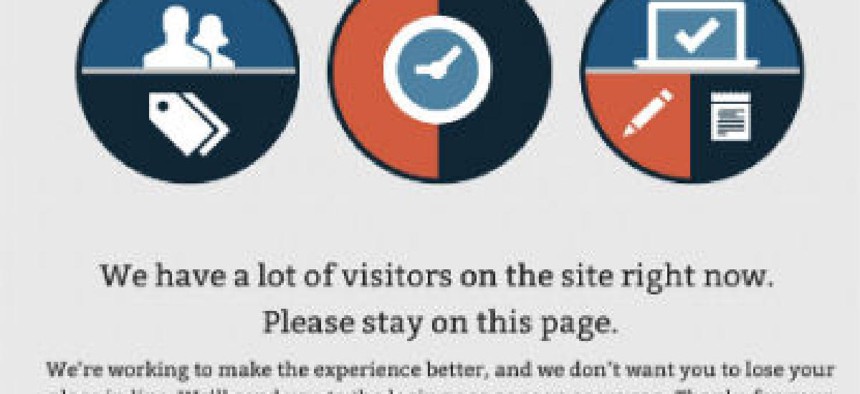What went wrong with HealthCare.gov?

Congressional hearing zeroes in on problems with testing, integration and project management.

A four-hour hearing on Capitol Hill confirmed that pre-launch testing of HealthCare.gov was inadequate given the size and scope of the project. Two IT contractors deeply enmeshed in the launch, CGI Federal and Quality Software Services Inc. (QSSI), confirmed reports that end-to-end testing was conducted only in the final weeks before the site went live, and no senior executive at the Center for Medicare and Medicaid Services was designated as the point person for integrating the various components of the system.
The poor performance of HealthCare.gov has led the Obama administration to press for fixes and urge Americans seeking insurance under the 2010health care law to apply over the phone, in person, or by mail. It also has led to recriminations from congressional Republicans, who are embarking on a series of hearings across several committees seeking answers about who was making decisions regarding the architecture and design of the site and when officials at CMS or the White House were informed about the results of testing.
QSSI played a role in the end-to-end testing of the system in the last two weeks of September, shortly before the Oct. 1 launch, and indicated that it communicated problems it found to CMS.
"We informed CMS that more testing was necessary," Andrew Slavitt, group vice president of Optum, the division of United Health that owns QSSI, told the House Energy and Commerce Committee on Oct. 24. He noted that a testing period for the project ideally would have lasted months rather than weeks. This view was echoed by Cheryl Campbell, senior vice president of CGI Federal. Both Slavitt and Campbell said they made no recommendations about whether CMS should delay the rollout of HeathCare.gov because such advice wasn't in the scope of their work.
Health and Human Services Secretary Kathleen Sebelius declined to appear, but will testify before the panel next week. Henry Chao, deputy CIO of CMS, and Chief Operating Officer Michele Snyder both named by Campbell as a points of contact for CGI Federal, could be asked to appear as well.
According to CMS, the system is continually improving thanks to daily bug fixes, but the contractors didn't have much to say about the current performance of Healthcare.gov. Several lawmakers made a show of trying to access the site via tablet computer during the hearing, but it seemed that even their ability to get through was divided along party lines, with Democrats claiming success and Republicans reporting otherwise.
The contractors offered no deadlines for the full functionality of HealthCare.gov, but did say that they expected applicants to be able to meet a Dec. 15 deadline for coverage beginning Jan. 1, 2014.
Questions from members tried to dig into when contractors knew about possible site failures and how they communicated the information to their counterparts at CMS. The final decisions on how to bring together the components of HealthCare.gov launch, make bug fixes, and launch on the open enrollment data mandated by statute were made by CMS. The agency "serves the important role of systems integrator or ‘quarterback’ on this project and is the ultimate responsible party for the end-to-end performance of the overall federal exchange," Campbell said.
Slavitt testified that he shared testing results with CMS after a Sept. 10 Energy and Commerce hearing, but before the Oct. 1 launch of the site. He said he didn't have direct knowledge of how any fixes were implemented.
The contractors also disclosed that CMS made the decision to disable an anonymous shopping feature two weeks prior to launch. The move is significant to Republican opponents of the law because the change required users to create an account and get a determination of their eligibility for an insurance subsidy before comparing plans. Critics charge the administration wanted to prevent "sticker shock" among shoppers out of concern that they might abandon the process before obtaining insurance -- "to hide the real cost of Obamacare from the American people" as Rep. Cory Gardner (R-Colo.) put it.
The witnesses did not take sides in that argument, but Slavitt confirmed that the registration requirement placed additional load on the Enterprise Identity Management (EIDM) tool that was part of QSSI's piece of HealthCare.gov. This may have contributed to some of the crashes and long wait times experienced by early users. According to Slavitt, the EIDM tool has been keeping pace with demand.
The demand explanation didn't sit well with Rep. Anna Eshoo (D-Calif.), whose Silicon Valley district is home to many technology companies. "There are thousands of websites that handle concurrent volumes far larger than what HealthCare.gov was faced with," Eshoo said. "I think that's a lame excuse. Amazon and EBay don't crash a week before Christmas."
Campbell also addressed the issue of faulty information being received by health insurance carriers, saying that corrections are in the works. This problem, in which insurers are receiving enrollment forms called 834s, is apparently so serious that it merited a White House meeting with insurance executives on Oct. 23 at which the administration announced the creation of "alpha teams" composed of technology experts from insurance companies and CMS to iron out problems with the forms. According to Campbell, CGI Federal is working to make sure there is an 834 attached to every enrollment.
The witnesses "gave the best answers they could," committee Chairman Fred Upton (R-Mich.) told reporters after the hearing. But he and other members indicated that people would have to wait for Sebelius to testify to find out whom at CMS, HHS or inside the White House was calling the shots on the launch of Heathcare.gov.
NEXT STORY: Want real innovation? Don't start from scratch!



